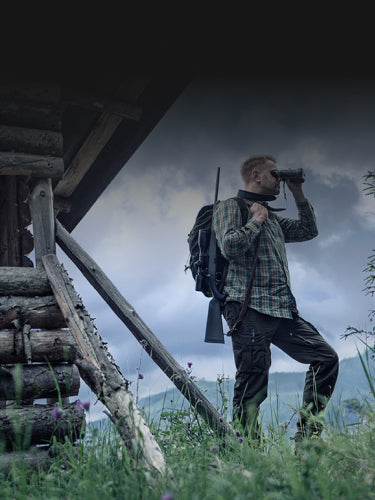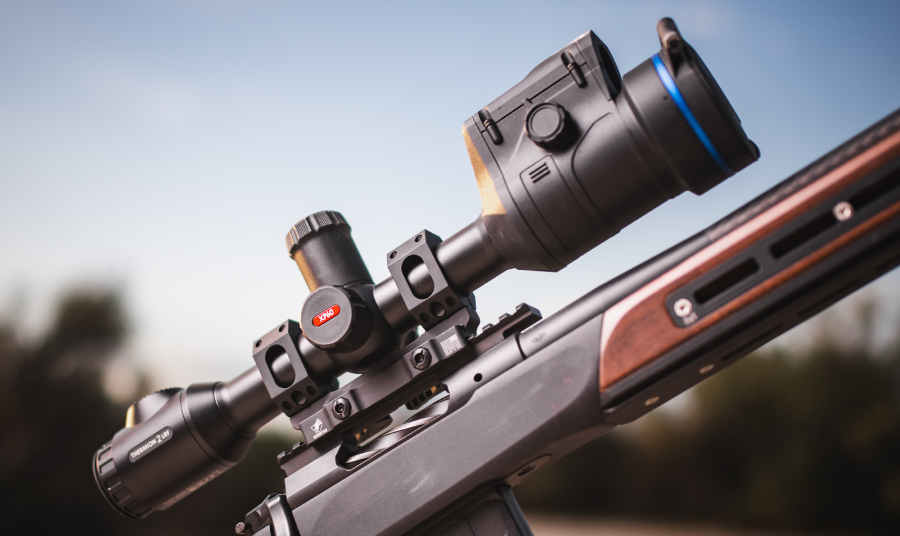You’re about to spend several thousand dollars on a piece of gear that claims to see heat, track animals through fog, and make you the apex predator of the night. You're nervous. You should be. That’s a good sign that you're taking this purchase seriously.
Your first thermal sight should never be an impulse buy. You’re about to invest in a high-tech tool that can completely change how you hunt, scout, or protect your property. You might be intimidated by those dense spec sheets full of Greek letters and numbers, but we promise you, they really do matter, and understanding what they mean will save you from wasting money on the wrong model. You don’t want something that looks impressive online but disappoints when it’s time to pull the trigger.
So let’s break down what those specs mean in real terms.
The Sensor
Every thermal sight starts with its sensor. This component detects invisible infrared radiation, ergo heat, and turns it into an electronic signal that the device can interpret as an image.
Uncooled vs. Cooled Sensors
You’ll see “uncooled” in almost every spec sheet, including Pulsar’s top models. Some beginners assume that means “cheap” or “less capable,” but this is not the case.
Cooled sensors are usually vehicle-mounted or installed in laboratories because they require enormous power supplies for their cryogenic systems. Normally found in tanks, helicopters, and satellites, they take several minutes to chill before they even start working, and are not ideal for a compact thermal imaging device like a riflescope.
Uncooled sensors, like those used in Pulsar’s Thermion and Talion lines, use solid-state microbolometers. No moving parts, no maintenance, and they start up in seconds. They’re rugged, silent, and reliable—perfect for real-world use.
If you see “uncooled microbolometer,” that’s not a downgrade. It’s the standard for field-deployable thermals that actually make sense for civilians.
Pixel Pitch
You’ll often see a number like 12 µm on a thermal spec sheet. That’s the pixel pitch—the size of each individual detector element on the sensor.
Smaller is better. A 12 µm sensor packs more thermal pixels into the same physical space than an older 17 µm sensor, giving you a finer image and longer effective range for the same lens size. Think of it like upgrading from a flip phone camera to a modern DSLR—it’s not just sharper; it captures more subtle differences.
The tradeoff? Smaller pixels require more precise lenses and tighter manufacturing tolerances. That’s why high-end optics cost what they do.
Sensitivity
Another figure you’ll see is NETD or sNETD, often followed by a number like “<20 mK.”
NETD stands for Noise Equivalent Temperature Difference. It measures how small a temperature change the sensor can detect. The lower the number, the better.
A thermal sight with sNETD <20 mK can distinguish heat differences of just two-hundredths of a degree Celsius. In the field, that means spotting a coyote through early morning fog or differentiating between a bedded hog and the stump it’s lying beside.
The “s” in sNETD means standardized, ensuring that manufacturers are using comparable testing conditions. So when you see “<20 mK,” you’re looking at elite-tier sensitivity—like in Pulsar’s Thermion 2 LRF XL60.
Resolution
Sensor Resolution
Your sensor resolution determines how much detail your thermal sight can actually capture. Common resolutions include 384×288, 640×480, and now, in Pulsar’s latest high-end models, 1024×768.
Higher sensor resolutions provide cleaner images and improved identification at a distance. If you’re scanning a pasture at 500 yards, you’ll notice the difference between a 384-core and a 640-core instantly.
In short: more pixels = more information = better identification.
Display Resolution
This is the screen you actually look at inside the sight—often an AMOLED panel. Some cheaper optics have good sensors but low-resolution displays, which bottleneck the image.
Pulsar avoids this by matching sensor and display resolutions in the same range—like the Thermion 2 LRF XL60’s 1024×768 AMOLED display, which renders every bit of detail the sensor captures.
Think of the sensor as your camera and the display as your TV. A 4K camera feeding into a 720p monitor still looks 720p. Both matter.
Frame Rate
Thermals don’t show a continuous image; they refresh it many times per second. That’s the frame rate, measured in Hertz (Hz).
A 50 Hz thermal refreshes 50 times a second—fast enough that motion looks fluid when you’re tracking a running hog or scanning a treeline from a moving vehicle. Lower frame rates (like 30 Hz) save power but produce choppier motion.
If you hunt fast-moving game or shoot on the move, 50 Hz is the sweet spot. It’s the industry standard for a reason.
Detection Range
Every brand lists a detection range, and it’s usually a big number—something like 2300 yards. However, that doesn’t mean you can positively ID a target at that distance.
-
Detection means the sight can tell something’s there—a heat blob.
-
Recognition means you can tell what type of thing it is (man, deer, cow).
-
Identification means you can see enough detail to know exactly what it is (buck vs. doe, boar vs. domestic pig).
The longer the range, the less likely you are to make a mistake—but don’t be fooled by max numbers. Use the ranges as relative comparisons, not guarantees. Real-world performance depends on humidity, terrain, and how still you are behind the rifle.
Lens Size and Field of View
A larger lens—say, 60 mm—gathers more infrared energy, giving you better detail at distance. The downside is weight and a narrower field of view.
If you hunt in tight brush or do more scanning than shooting, a 35 or 50 mm lens is often the better call. Bigger isn’t always better. It’s important to match your sight to your environment.
Palettes, Zoom, and Image Processing
Color Palettes
“White Hot” and “Black Hot” are the two workhorses.
-
White Hot: intuitive and high-contrast—most users’ default.
-
Black Hot: easier to read in bright or reflective environments.
-
Color palettes like “Red Hot” or “Sepia” can help highlight targets but are personal preference.
Digital Zoom
Digital zoom enlarges pixels, not detail. A 640×480 sensor zoomed 4× is still showing fewer real pixels than a 1024×768 core at 2×. That’s why high-resolution sensors are worth the extra cost: they tolerate zoom without blurring into pixel soup.
Pulsar’s software (Image Boost, detail enhancement algorithms) minimizes degradation, but physics still applies.
Battery Systems, Calibration, and Build Quality
Power
Quick-swap batteries like Pulsar’s APS5 series are lifesavers in the field. Expect around 8–10 hours of runtime per cell, depending on temperature and refresh rate. Carry spares.
Cold weather drains batteries fast, so keep them in an inside pocket until needed.
Calibration (NUC)
You’ll occasionally hear a quiet click or shutter noise during use. That’s NUC (pronounced nuke) —Non-Uniformity Correction. It recalibrates the sensor to maintain consistent image quality.
Some thermals let you control it manually; Pulsar offers auto, semi-auto, and manual modes. Without NUC, the thermal image slowly degrades over use, and periodic refreshment is absolutely necessary.
Build
High-end thermals use magnesium alloy housings for strength and heat dissipation. Check recoil ratings: if you’re mounting to a .308 or above, make sure the optic is rated accordingly. Pulsar’s are built for heavy recoil.
Every gram of extra metal in a Pulsar sight is there for a reason—cooling, rigidity, or durability. It’s not just weight for weight’s sake.
Putting It All Together
Choosing a thermal sight isn’t about chasing the biggest number on the spec sheet. It’s about balance and purpose.
-
Predator hunters need detection range and refresh rate.
-
Hog hunters need sensitivity and a wide field of view.
-
Ranchers and property owners need battery life and identification clarity more than anything.
If you can afford it, purchase a unit with the best sensor resolution and NETD available. Those are the two specs that truly separate “good” from “great.” But don’t buy a 4-pound 60 mm monster if all your shots are under 150 yards. Weight and usability count for more than you think.
Every seasoned thermal user once stood where you are now—squinting at spec sheets, wondering what half those numbers meant, and terrified of buying the wrong optic. The truth is, once you understand what those stats really describe, the choice becomes clear.
Explore Pulsar’s full lineup of thermal sights, from compact monoculars to flagship riflescopes like the Thermion 2 LRF XL60, and find the one that fits your hunt.
Frequently Asked Questions
What’s the difference between cooled and uncooled thermal sensors?
Cooled sensors require large power supplies and cryogenic systems, making them suitable for military or laboratory use, not handheld devices. Uncooled sensors, like those in Pulsar’s Thermion and Talion lines, use microbolometers that start instantly, are maintenance-free, and are ideal for civilian and field use.
Why does pixel pitch matter in a thermal sight?
Pixel pitch measures the size of each detector element on the sensor. Smaller values, such as 12 µm, mean higher image detail and longer detection range. However, smaller pixels require more precise lenses, increasing cost but greatly improving performance.
What does NETD mean and why is it important?
NETD, or Noise Equivalent Temperature Difference, indicates a sensor’s thermal sensitivity. A lower number means the optic can detect finer temperature differences. For example, an sNETD below 20 mK can distinguish objects that differ by just 0.02°C—critical for spotting animals through fog or brush.
How far can I really see with a thermal sight?
Manufacturers list detection ranges that show how far the optic can detect heat, but detection doesn’t equal identification. Detection means you see a heat source, recognition means you know the type of target, and identification means you know exactly what it is. Real-world range depends on weather, terrain, and skill.
What’s more important—resolution or lens size?
Both matter, but in different ways. Higher resolution provides finer detail for identifying targets, while a larger lens gathers more infrared energy for long-range detection. For dense brush or short-range use, a smaller lens offers better field of view and lighter handling.




